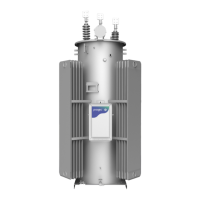GEH-7299A: Installation, Operation and Maintenance Manual
for Type VR1™ Single-Phase, Step Type Regulators
prolec.energy/prolecge 29
Trouble Cause Remedy
Regulator
will not
operate either
automatically
or manually
or remains in
maximum lower
or maximum
raise position.
Loss of sensing
signal from the
regulator.
Check for control sensing voltage at the voltage test terminals on the front of
the control panel with an AC voltmeter. If no voltage occurs at this point, either
the external power supply switch or the circuit breaker is defective. Check
for sensing voltage between NN-9 and NN-10. If no voltage appears at these
terminals, refer to nameplate for proper jumper connection from terminal board
NN-20, NN-21, NN-22 to NN-9. If jumper is correct, the problem is outside the
controls. If voltage does appear at this point, check for faulty external power
supply switch or a faulty circuit breaker.
Motor circuit is
not functioning
properly or
the control
switch may be
defective.
If correct voltage is measured at the voltage test terminals, place the motor
control switch to RAISE position (check to ensure the regulator is not in the
maximum RAISE position). Place an AC voltmeter (150-volt scale) between
NN-27 and NN-26. If voltage is not measured here, the control switch is faulty. If
voltage does appear here, the motor circuit is defective.
Indicator limit
switches are
not operating
properly.
Check the position-indicator switch mechanism. Refer to MAINTENANCE
section concerning removal of the indicator dial.
Warning: Before removing the indicator dial assembly, de-energize the
regulator.
Regulator
functions
manually but not
automatically in
either raise or
lower direction
Defective DC
power supply
located on the
component
board
assembly
Check the sensing circuits and relay voltage supply circuits by setting the
Control Switch to TEST and observing the band-edge indicator lights. This
check is made with 120-volts, supplied to the control from either the internal
regulator supply or an external source. To use an external source, attach power
supply leads to the test terminals marked EXTERNAL and place the Power
Supply switch on External. Vary the voltage level adjustment control in and out
of the bandwidth, above and below 120-volts.
If the band-edge indicating lights (high and low) show the correct voltage level,
the voltage supply to the relay in correct. If they do not, check the DC voltage
per Table 5.
Defective time-
delay circuit
and complete the ground circuit for the relays. Test time-delay rheostat R25
with a multi-test meter.
Warning: Before disconnecting any plug connector between the control panel,
component board and nn terminal board or disconnecting any connection to
the NN terminal board, remove the control cable ug from the bottom of
the position indicator housing. Remove the external power supply used for
testing when trouble shooting is completed.
disconnecting the multipin plug located in the lower right-hand corner of the A1
circuit board. Replace the rheostat if it is defective. If the rheostat is normal, the
problem will be located on the board assemply. Replace the component board.
Defective
motor leads
If the relays pick up and drop out properly but the motor does not become
energized, check the motor leads at NN-26, NN-27 and NN-28.
Table 8. Trouble Shooting Chart

